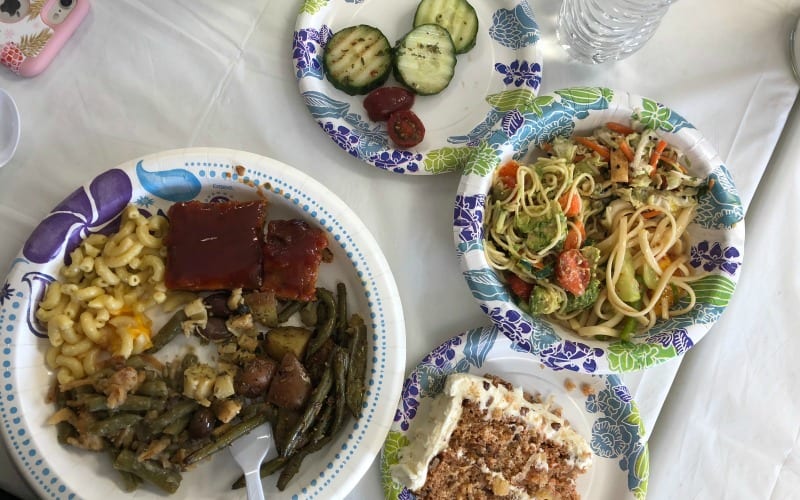How to Feed Your Family Well + Printable Table Setting Template
Every family has unique preferences when it comes to food, but most of us can agree – we want to eat well! Today I’m talking about how to feed your family well and what that can look like for anyone – on any budget. Plus, you’ll find a fun printable table setting template to help you and your kids remember how to properly set a table!

30 Days Of Intentional Homemaking: Day 20
Families need women who make home a special place to live, learn, and grow. There is no other job that presents as many opportunities for shaping (for the good or the bad) the future of our country – of our world – than that of a homemaker.

Each of us is a homemaker. Whether you work outside the home or stay home full time, you are a homemaker. Whether you live with a big boisterous family or it’s just you and a couple of children – or just you and your husband – or even just you -, you are a homemaker. We’ve all been called to the ministry of homemaking.
Eating well isn’t just about slaving in the kitchen over a hot stove all day preparing recipes like your great grandma did. Most of us today don’t have time to spend all day preparing meals. Although, for years I spent a lot of time in the kitchen preparing meals to feed our very large family.
Since then, I’ve learned how to not only save money on groceries, but how to also save time in the kitchen so I can feed my family and we can enjoy a good meal without being a slave to the stove.
Much of family life revolves around food. After all, food is a basic need and most people eat 2 – 3 meals every day. That’s about 21 meals a week you’re feeding your family every week – and up to 7,665 meals every year! No wonder mamas are tired!
In her book, How to Be a Happier Parent, author KJ Dell’Antonia says, “The first step toward happier family meals is to really want happier family meals. If you see the whole thing just as a chore, you’re writing off something wonderful and consigning what constitutes the bulk of time your family will spend together into the “have to” bin. The dinner hours are when we nourish our families in every sense of the word.”
She goes on to say, “You don’t have to get it right every time. No one single dinner makes a family. It’s the accumulation of all that time together, in the kitchen, at the table, eating whatever it is you’re eating. That time should be a source of peace and solace, and even joy, no matter what’s on the plate or the conversational menu.”
How to Feed Your Family Well
My kids love to eat good food. I’ve raised five hungry kids and while I only have two teen girls still at home, eating good food is important to all of us. My girls love to eat healthy food that makes them feel nourished.
I can honestly say that when we eat a meal that makes us feel sluggish or unhealthy, they will tell me it wasn’t worth it! So it’s important to me to make sure I’m feeding them food that fuels their bodies and helps them grow, learn, and excel in their chosen sports.
Last time we talked about the why family dinners are important and how we can connect as a family around the table. I believe that food brings people together – family and friend, loved ones, and neighbors all feel a sense of belonging when they connect over a meal.
Save Time in the Kitchen
Serving a good meal – no matter whether it took 15 minutes to throw together or an hour to bake in the oven – is a way to minister to those you love. When you feed your family well, you are ministering not only to their bodies but also to their souls.
Meals don’t have to be elaborate to be meaningful. There is nothing wrong with serving simple meals that don’t take a long time to prepare. There are a number of ways you can save time in the kitchen and feed your family well.
1. Use a crock pot. Using a crock pot to prepare your evening meal – or even a warm breakfast – can save you a lot of time. I love using a crock pot on days when I know I’ll be extra crunched for time. Add a side of rice, some steamable veggies, and/or some bread and you have a complete meal in no time. We eat a lot of ready to eat, microwavable brown rice from Trader Joe’s.
2. Try meal prepping. On weekends, or which ever day works best for your schedule, go ahead and get a few things done so you have less work to do when everyone is ready to eat. By preparing some of your meals ahead of time, or even just dicing the vegetables ahead of time, you can prepare your meals with less work and less time.
3. Prepared foods. Honestly, when my kids were younger I had it in my head that I needed to prepare everything we ate from scratch. I had very high expectations for myself. Moms do that to themselves all the time!
Our family is vegetarian and eating healthy foods is a big priority. And I thought I needed to make everything from scratch. Seriously. Not necessary. I mean, if you have the time, that’s wonderful. If it makes you happy and gives your day meaning and you look forward to working in the kitchen and you have time, I’m all for it.

I love cooking and I love baking. But one day I realized that I was exhausted and putting too much pressure on myself. And I decided that during this season of my life that it was okay for me to sometimes serve my family food that was prepared not by me. My favorite place to shop for prepared foods is Trader Joe’s.
related: My Go-To Meals for Busy Days
4. Serve simple food. As I mentioned above, meals do not need to be elaborate or hard to prepare to nourish your family and be enjoyed by everyone. Frozen veggies that can be steamed in the bag are healthy, inexpensive, and only take a few minutes to prepare making a simple but delicious side dish.
How Much Should You Spend on Food
According to the USDA, the average American family of four can eat a healthy diet spending $150 – $300 a week on groceries.
Pizza, burgers and fast food every night can put a strain on your budget as well as your health. But grocery shopping can get expensive too. The Bureau of Labor Statistics found that food is the third biggest budget expense for most households.
The average grocery bill for a month for a family of four averages around $550 for the super thrifty and over $1,300 for those with a bigger budget.
So how do you manage to feed your family healthy meals while still keeping your budget in line? Here are a few tips that will help you reduce your monthly spending by as much as 25%.
- Start with a list. Always have a plan when you go shopping. Review the weekly ads in advance and make your list based on the best deals. This will help you avoid over-buying and it will get you in and out of the store much faster.
- Focus on what’s on sale. Your list should have several sale items listed each week. Build your meals for the week around the sales at your local store.
- Take advantage of rain checks. If the store runs out of the sale item, ask for a rain check. Then, you can purchase the item when it’s been restocked and still pay the sale price.
- Don’t shop hungry. Being hungry will cause you to be less patient and keep you from having self-control, which will leave you susceptible to impulse buying (adding extra expenses to your grocery bill). Do yourself a favor and have a snack before you shop. Your wallet will thank you too!
- If an item is on sale, stock up on it! It’s always a good idea to stock up on sale items. Especially when it comes to canned, frozen or packaged foods. They will allow you plenty of time to use them. Plus, when you stock up on canned and frozen vegetables, rice and pasta, you always have sides in your pantry. This means you’ll only have to shop for meat when it’s on sale to complete your meal plan.
- Freeze foods you stock up on when appropriate. If you have some freezer space, stock up on food items when their on sale. This can save you a bundle and you’ll always have something healthy to easily throw together for dinner. Plus, you can use sale items to prepare freezer meals ahead of time so you always have a meal ready to heat and eat!
- Look for recipes where you can use leftovers so you don’t have any waste. A little advance planning and storing will keep your family eating healthy without breaking the bank.
3 Reasons Why Family Meal Times are Important
Busy schedules and families moving in opposite directions make it hard to have “family dinners.” But, with all the benefits they offer, it’s worth it to come together at the table at least a few times a week.

Speaking of benefits, here are just a few that will make you want to sit down with your family tonight.
#1 Conversation. Eating dinner together provides the opportunity for great conversation. This time allows parents to teach healthy communication skills without the distractions of smart phones, television, and computers. By encouraging conversation with your child, you teach them how to listen and you provide them with a chance to express their own thoughts and ideas. Conversations expand your child’s vocabulary and reading ability.
#2 Development. The sense of security and togetherness your child feels by having family meals together helps nurture them into healthy, well-rounded adults. Regular family dinners have a positive impact on their values, motivation, and self-esteem. Research shows that children who eat dinner with their family are more likely to understand and follow the boundaries and expectations their parents set.
To make the most of your family mealtime, turn off television and mobile devices, get together at least four times a week, encourage positive conversation, and spend at least an hour together eating, having conversation, and cleaning up together.
#3 Nutrition. Eating together also encourages healthy eating habits and provides a tradition for your child to carry with them into adulthood. Research shows that family dinners increase the consumption of fruits and vegetables. Families who eat together also tend to eat fewer fried foods and drink less soda. And the frequency of family meal time is linked to the intake of protein, calcium, and vitamins.
To provide the most nutritional benefits, cook together as a family and include everyone in the preparation, experiment with fun recipes, and remake your favorite old recipes with healthier alternatives.
You might also enjoy having “theme” cuisine nights like Italian or Mexican. Know your child’s favorite meals and cook them on a regular basis so they’ll enjoy their time at the table. You can even encourage your child to create their own recipes.
Regular family meals may require a little effort to plan, but the benefits in mental and physical health to are more than worth it.
Family Meals Around the Table
Setting the table doesn’t have to take a lot of time. In fact, it’s perfectly okay to use paper plates if you’re in a crunch or short on time. Sometimes we use paper plates when it’s just us at home and I’m busy working or need some grace in my life.
And very often I let the kids serve themselves from the stove and then we all go sit at the table together. The point, do what it takes to make it happen. Make meal times a priority.


Setting a pretty table certainly makes your family and friends feel extra special. And why not make the effort when you have time to set the table and welcome your family to a well thought out meal and table?
The ministry of homemaking is not simply about checking off a list of to do’s, it’s about making your family feel well loved and cared for by providing them a space that comforts and welcomes them with warmth and loving care.

The atmosphere of the home largely depends on the enjoyment of life – the enjoyment of simple pleasures that a family can delight in together. Warmth, gratitude, appreciating good food and conversation, knowing and being known, laughter and happiness can all be experienced around the table.
related: The Ministry of Homemaking
Many families find themselves struggling to even sit together around the table for a meal but research shows that having dinner as a family at least four times a week has positive effects on your child’s development. Family dinners have been shown to lower your risk of obesity, substance abuse, and eating disorders.
Here’s the thing. Family dinners don’t just magically happen. You have to make them happen. It has to be something you value. Knowing how important family meals around the table are, taking the time to make it happen on a regular basis is definitely worth the little bit of extra effort!
Jenny Rosenstrach, author of the book, Dinner: A Love Story says, “Family dinner is a mindset, and once you get comfortable with the idea of not doing it, the harder it becomes to make it happen. But the more you force yourself to make meals for your children, the more it will become second-nature, and the more addicted you’ll get to all the pleasures and dividends a family meal can yield.”
And remember, even if your family meal consists of frozen pizza and a bagged salad, it’s okay. Just take time each week to eat together, talk, laugh, connect, and make memories.
And you know what else? While I believe that homemade food and family dinners at home make some of the most precious memories, I’d say that eating around the table in a restaurant counts too. At least it does in my book. Our family is on the road a whole lot. Sometimes we travel for weeks at a time. That means we eat out.



However you connect around the dinner table, what’s important is that you spend that time together.
Setting the Table
In my house, I love setting a pretty table. Every so often I will change out the centerpiece on my dining room table as well as my kitchen table. I love to decorate based on the seasons or holidays and having something pretty to look at in the center of your table can really add something to the mood.
Setting a pretty table and enjoying good conversation while slowly consuming your meal aids in your digestion, enjoyment, and health. Food is such an integral part of our existence as human beings and even Solomon acknowledged that we should enjoy the sweet and simple pleasures not out of greed or arrogance but with a thankful, joyful heart.
“So I commend the enjoyment of life, because there is nothing better for a person under the sun than to eat and drink and be glad. Then joy will accompany them in their toil all the days of the life God has given them under the sun.” Ecclesiastes 8:15
Of these verses, Matthew Henry says, “Faith alone can establish the heart in this mixed scene, where the righteous often suffer, and the wicked prosper. Solomon commended joy, and holy security of mind, arising from confidence in God, because a man has no better thing under the sun, though a good man has much better things above the sun, than soberly and thankfully to use the things of this life according to his rank. He would not have us try to give a reason for what God does. But, leaving the Lord to clear up all difficulties in his own time, we may cheerfully enjoy the comforts, and bear up under the trials of life; while peace of conscience and joy in the Holy Ghost will abide in us through all outward changes, and when flesh and heart shall fail.”
How to Set the Table
Setting the table for each meal doesn’t have to take a lot of time. An informal table setting is all you need to do for your regular weekly meal time. You can set a more formal table for special occasions.
Setting the table should only take a few minutes and it’s a perfect chore for other family members. Teaching children how to properly set a table is a valuable skill they need.
Basic Table Setting Instructions
- Set place mat on the table or use a table cloth as desired.
- Put dinner plate on the center of place mat.
- Fold napkin and place in center of plate or to the left of the plate.
- Place fork to the left of the dinner plate and on top of napkin if not in center of plate.
- Place salad fork to the left of the fork if you are serving salad.
- Place knife to the right of dinner plate with the blade pointing toward the pate.
- Place spoon to the right of the knife.
- Place cup at the 1:00 position to the right of the dinner plate above the knife and spoon.
- If you use a salad plate and/ or bowl, you can place these on top of the dinner plate.
Things to Remember
- Knife blades always face the plate.
- You only set the table with utensils and dishes you will be using.
- The bread and butter knife is optional and used at your discretion.
Tips for helping you and your kids to remember the order of plates and utensils from Emily Post’s website:
Picture the word “FORKS.” The order, left to right, is: F for Fork, O for the Plate (the shape!), K for Knives and S for Spoons. (Okay, you have to forget the R, but you get the idea!)
Holding your hands in front of you, touch the tips of your thumbs to the tips of your forefingers to make a lowercase ‘b’ with your left hand and a lowercase ‘d’ with your right hand. This reminds you that “bread and butter” go to the left of the place setting and “drinks” go on the right.
Free Printable Place Setting Template for Kids

How to Get the Printable
- Just fill out the form below and you’ll receive an email with the link to get your free printable checklist. You’ll also receive helpful emails and updates from me on a regular basis!
- Or, you can purchase this printable place setting template here for just $2.97.
- If you are already a subscriber, you can still fill out the form below to get the printable – it won’t affect your subscription!
Place Setting Guide for Kids

Join A Virtuous Woman's community of over 21,000 women where you'll find freedom from perfection and the confidence to live your life with purpose. Get my FREE GUIDE: How to Set the Table for Kids!








6 Comments